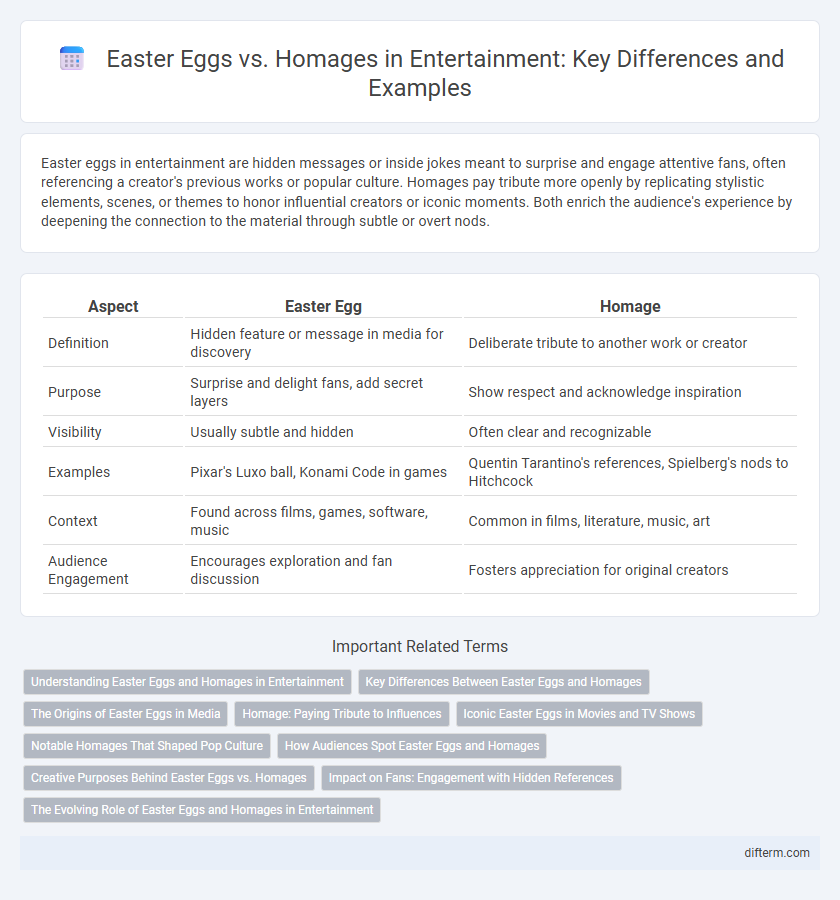Easter eggs in entertainment are hidden messages or inside jokes meant to surprise and engage attentive fans, often referencing a creator's previous works or popular culture. Homages pay tribute more openly by replicating stylistic elements, scenes, or themes to honor influential creators or iconic moments. Both enrich the audience's experience by deepening the connection to the material through subtle or overt nods.
Table of Comparison
| Aspect | Easter Egg | Homage |
|---|---|---|
| Definition | Hidden feature or message in media for discovery | Deliberate tribute to another work or creator |
| Purpose | Surprise and delight fans, add secret layers | Show respect and acknowledge inspiration |
| Visibility | Usually subtle and hidden | Often clear and recognizable |
| Examples | Pixar's Luxo ball, Konami Code in games | Quentin Tarantino's references, Spielberg's nods to Hitchcock |
| Context | Found across films, games, software, music | Common in films, literature, music, art |
| Audience Engagement | Encourages exploration and fan discussion | Fosters appreciation for original creators |
Understanding Easter Eggs and Homages in Entertainment
Easter eggs in entertainment are hidden references or inside jokes intentionally placed by creators for attentive audiences to discover, enhancing fan engagement through subtle connections. Homages explicitly acknowledge and pay tribute to influential works, styles, or creators, often replicating elements to honor their impact on the medium. Distinguishing Easter eggs from homages deepens appreciation of narrative layers and artistic influences across film, television, and video games.
Key Differences Between Easter Eggs and Homages
Easter eggs are hidden messages or features embedded within a work, often discovered by dedicated fans, while homages explicitly pay tribute to another piece of media or creator. The key difference lies in intent and visibility; Easter eggs are subtle and meant to be uncovered, whereas homages are more overt and recognizable references. Both enrich entertainment by creating intertextual connections but serve distinct purposes in audience engagement.
The Origins of Easter Eggs in Media
Easter eggs in media originated as hidden messages or inside jokes embedded by creators to engage attentive audiences, dating back to early video games and films of the late 20th century. Unlike homages, which openly celebrate or reference influential works or figures, Easter eggs remain subtly concealed, requiring keen observation or insider knowledge to uncover. This practice has evolved into a popular interactive element across movies, video games, and literature, enhancing viewer or player experience through discovery and connection.
Homage: Paying Tribute to Influences
Homage in entertainment honors influential works or creators by thoughtfully incorporating styles, themes, or elements that shaped the original art, deepening audience appreciation. Unlike Easter eggs, which are subtle hidden references meant as surprises, homages are deliberate tributes that highlight respect and admiration for predecessors. This practice enriches storytelling and connects contemporary creations with the legacy of cultural milestones.
Iconic Easter Eggs in Movies and TV Shows
Iconic Easter eggs in movies and TV shows serve as subtle nods to fans, often hidden references that enrich the viewing experience without disrupting the narrative. Unlike homages, which explicitly honor a particular work or creator, Easter eggs are designed as playful secrets, such as the recurring appearance of the numbers "1138" in George Lucas films or the hidden Mickey Mouse shapes in Disney productions. These clever inclusions create a deeper connection between the audience and the creators, showcasing attention to detail and a layered storytelling approach.
Notable Homages That Shaped Pop Culture
Notable homages in entertainment often pay tribute to influential works by replicating iconic scenes, styles, or themes, thereby reinforcing cultural legacies and inspiring new creative interpretations. Unlike Easter eggs, which are subtle hidden references meant for dedicated fans, homages are explicit acknowledgments designed to celebrate and elevate the original work within the broader narrative. Examples include the homage to Alfred Hitchcock's suspense techniques in modern thrillers and the recurring cinematic nods to classic Star Wars motifs in contemporary sci-fi films.
How Audiences Spot Easter Eggs and Homages
Audiences spot Easter eggs and homages by recognizing subtle references, familiar symbols, or iconic scenes that connect to other works or cultural moments within films, TV shows, or video games. Fans often engage in active viewing, analyzing visual cues, dialogue, or background details that hint at hidden meanings or pay tribute to creators, characters, or genres. Online communities and fan theories further enhance detection by sharing insights and decoding obscure connections between entertainment properties.
Creative Purposes Behind Easter Eggs vs. Homages
Easter eggs serve as hidden, playful elements designed to surprise and engage audiences through secret nods or inside jokes, often enriching the interactive experience in films, games, or media. Homages intentionally honor or pay tribute to influential works, creators, or cultural milestones, emphasizing respect and recognition rather than secrecy. Both techniques creatively deepen viewer connection, but Easter eggs prioritize discovery and interactivity, while homages emphasize reverence and inspiration.
Impact on Fans: Engagement with Hidden References
Easter eggs create an interactive experience, encouraging fans to actively search for and share hidden references, which deepens their connection to the content and community. Homages evoke nostalgia by directly paying tribute to iconic works or creators, fostering appreciation among fans familiar with the original material. Both techniques enhance fan engagement by inviting recognition and discussion, enriching the entertainment experience through layered storytelling.
The Evolving Role of Easter Eggs and Homages in Entertainment
Easter eggs and homages serve distinct but complementary roles in entertainment, with Easter eggs offering hidden surprises that engage attentive audiences, while homages pay deliberate tribute to influential works or creators, enriching the narrative context. The evolution of digital media and fan culture has amplified the prevalence and complexity of Easter eggs, transforming them into interactive elements that deepen viewer immersion and community engagement. Homages, often rooted in respect and reverence, provide creators with tools to acknowledge their inspirations, fostering a layered storytelling experience that resonates across generations.
Easter egg vs homage Infographic

 difterm.com
difterm.com